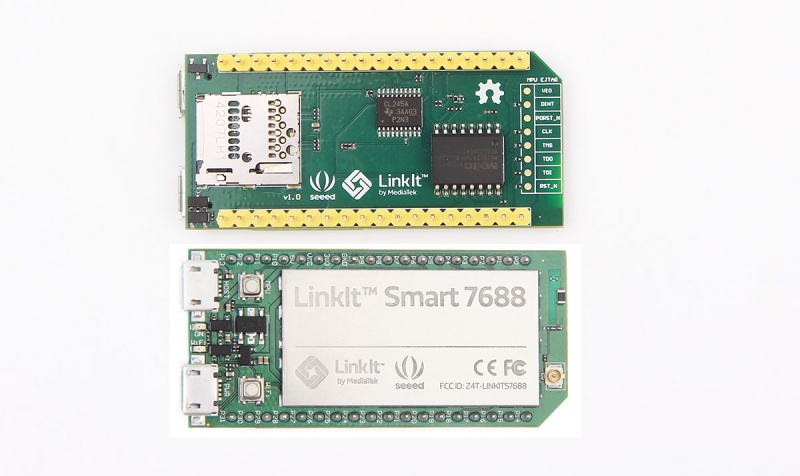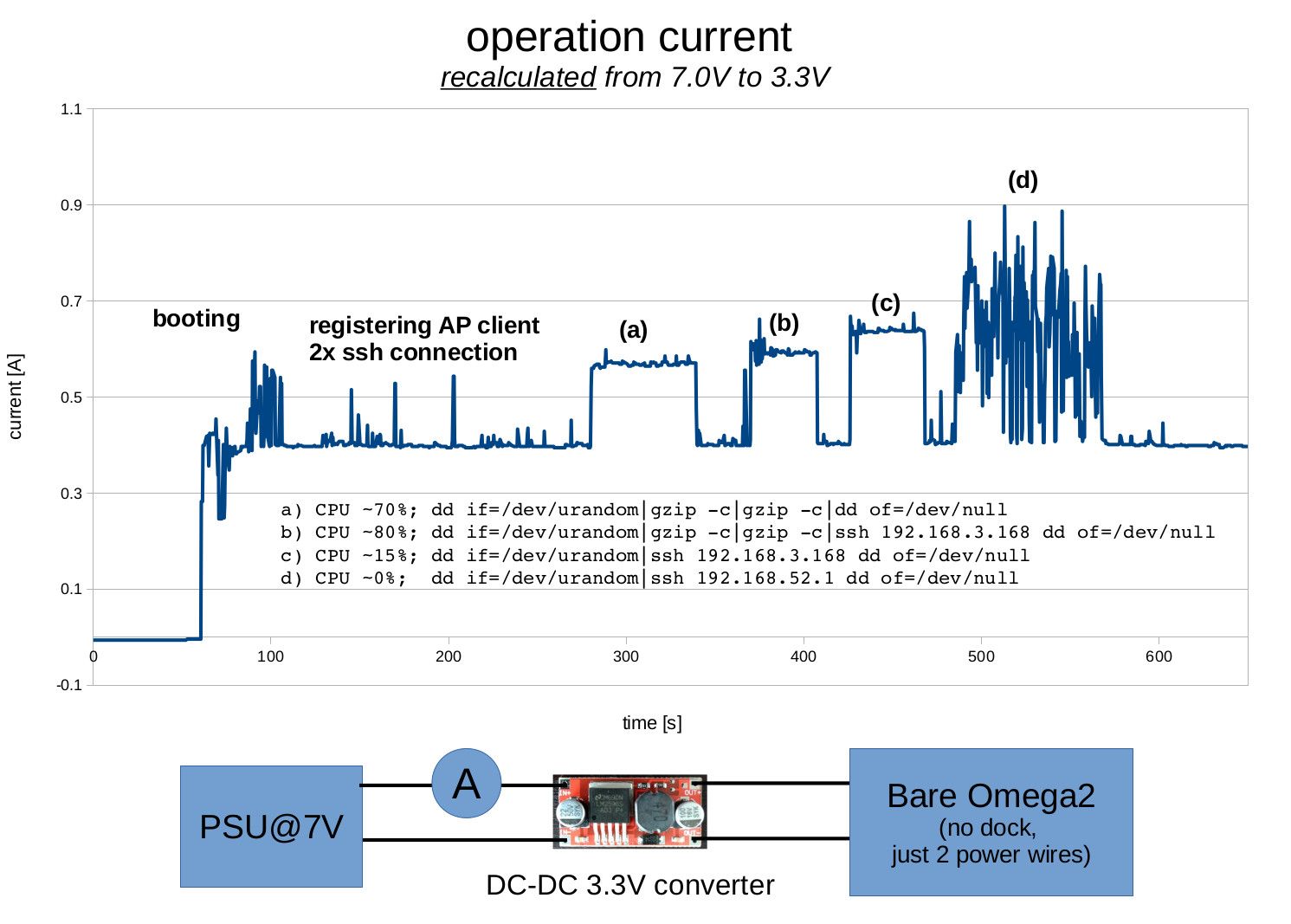Power consumption scenarios of an Omega2+ like board
-
The title was "MediaTek LinkIt Smart 7688 Developer's Guide" formerly.
Last edited 2017-05-05.This interesting stuff ( I mean this Guide, see below) is fairly new for me.
These - almost unbelievable - Typical power consumption scenarios on page 8 explain lots of power supply issues.
First of all I don't want to promote this board here. Period.
But, unfortunately Omega2(+) has not any formal power consumption data so I share this - hopefully official - "Typical power consumption scenarios" table of a comparable gadget.
(MT7688AN SOC based , 580 MHz MIPS CPU, 32 MB flash, 128 MB DDR2 RAM, USB host, Micro SD slot).As you probably know, the hardware of a LinkIt Smart 7688 almost equivalent with an Omega2+ and a Mini Dock combo.
The main differences are:- it does not have SERIAL-TO-USB chip
- its USB host port is a micro USB connector without TVS protection
- it does not have Power Switch
- it can be plugged into a breadboard directly (9x0.1" wide, 0.1" spacing pins)
LinkIt Smart 7688 Developer’s Guide Version: 1.1 Release date: 22nd February 2016
I have not any Mini Dock. I compared its schematic to this reference design. Please correct me if I am wrong.
-
@György-Farkas good find! Maybe you should change the title to something like "Useful info on power consumption", so people struggling with power supply issues will see it

-
@luz
OK. I changed it and edited the text.
I think MEDIATEK Labs site was a good find indeed. :slight_smile:
-
György's post reminded me that I had a nice tool (VA18B) bought ca 7y ago. Dusted it off a bit.

Remarks:
- I coudn't make the Omega to boot when the meter was inserted after the DC-DC converter. Also, it didn't boot when the Vout of PSU was set to 5V.
- The 192.168.52.1 is the WLAN the Omega registers to itself. The reception in the place I ran the tests is poor so I am not sure if this extra power need is because of going over two wlans or because of the poor reception (seems the first one).
- the sampling rate of the multimeter seems to vary between 1 and 5Hz so the peaks (spikes) should be considered as "at least".
- the DC-DC converter draws unloaded ca 7mA
If anybody is interested in any specific test based on the above setup, please let me know. I have Omega2, Omega2plus and the mini-dock.
-
@Marcin-Debowski Nice plot of the current under various Omega2 CPU loads. Your baseline of ~.40A is approximately double of the .18 - .20A that I and others measure with Omega2 at ~2% CPU. Any chance you are off by a magnitude of 2? Also, it seems odd that b < c when bCPU > cCPU. Can you reproduce that?
Would be better to have the Amp meter after the DC-DC convertor. Perhaps there is a voltage drop across the meter?
-
@Ken-Conrad, was your baseline for 3.3V? If it was for 5V this would be not that far off (possibly) taking into account the converter under the load.
In my other post on the cheap converters for 5V Vin the idle (stable) Omega2 current was 170-190mA.I tried to put the meter directly before the Omega but it didn't boot. The lead wires look solid but it is still the Chinese-who-knows-what-inside stuff.
-
@Marcin-Debowski Yes baseline at 3.3V. I use a common bench power supply that has a variable volts output and displays the current drawn, in amps. I believe you have a similar power supply? I have my supply set to 3.3- 3.4V and the amp meter nicely displays the current required at that particular moment of the Omega boot, etc. Not a graph providing setup, but useful and accurate.
I just reread this thread. It is about various problems users had powering their Omegas, including your posts about tests with small Chinese made power supply boards. You mentioned powering an Omega with 5 volts. By accident I did that once with a bare Omega for an hour or more. It ran fine, but got quite hot. After that it always required at least 3.4v to boot completely and now it draws more current ... I believe the 5 volts changed or degraded something in that Omega.
What confuses me is your statement "recalculated from 7.0V to 3.3V". What did you do here? Did you calculate the amps at 3.3V by Ohm' Law for a constant load: A = 7/3.3 x (current measured at 7v) ?
To check your setup you could run this test - in place of the Omega wire a known resistive load, say 80 ohm 1/4 watt resistor or 16-20 ohm 1 watt resistor. Use your graphing to measure the current. Checking with Ohm's law, does the graph make sense?
-
Place the ammeter on the output side of the DC-DC inverter.
The solution is to put a 470uF 6.3V eletrolytic capacitor near the output sied of DC-DC inverter.
This is not intuitive and from common practice, since the best practice is to place such capacitor nearest to Omega2's power supply pins.The point is to make sure on the power supply end that it can offer sufficient current during impulse demand. E.g., around 20 second into the boot sequence, WiFi radio is turned on. This causes high inrush current and if inadequate power supply, the voltage will drop and Omega2 goes into brown out state (amber LED extinguish.)
With a large capacitor added, it makes sure Omega2 won't crash while the current demand won't be smoothed out too much.
If the power consumption got too much smoothed out, try to change the capacitor to a smaller value, say 100uF 6.3V. Small but not too small to see the effect of Omega2 crash, that is.ccs_hello
-
@ccs-hello said in Power consumption scenarios of an Omega2+ like board:
Place the ammeter on the output side of the DC-DC inverter.
The solution is to put a 470uF 6.3V eletrolytic capacitor near the output sied of DC-DC inverter.To do this right I would need to place the capacitor between the ammeter and Omega. I expected this would "flatten" the characteristics (make a sort of running average) and I wanted to see the spikes of the current if any. What I mean, I expected the recorded current to be in this case strongly dependent on the charging / discharging characteristic of the capacitor and only indirectly on the Omegas short-time load demand - is this assumption correct?
-
@Ken-Conrad said in Power consumption scenarios of an Omega2+ like board:
@Marcin-Debowski Yes baseline at 3.3V. I use a common bench power supply that has a variable volts output and displays the current drawn, in amps. I believe you have a similar power supply? I have my supply set to 3.3- 3.4V and the amp meter nicely displays the current required at that particular moment of the Omega boot, etc. Not a graph providing setup, but useful and accurate.
Yes, I have it too and I noticed the difference of ca 10% what I contributed to the wires.
I just reread this thread. It is about various problems users had powering their Omegas, including your posts about tests with small Chinese made power supply boards. You mentioned powering an Omega with 5 volts. By accident I did that once with a bare Omega for an hour or more. It ran fine, but got quite hot. After that it always required at least 3.4v to boot completely and now it draws more current ... I believe the 5 volts changed or degraded something in that Omega.
I am pretty sure I didn't power it with 5V but I will cross-check the load with the Omegas2plus I have.
What confuses me is your statement "recalculated from 7.0V to 3.3V". What did you do here? Did you calculate the amps at 3.3V by Ohm' Law for a constant load: A = 7/3.3 x (current measured at 7v) ?
To check your setup you could run this test - in place of the Omega wire a known resistive load, say 80 ohm 1/4 watt resistor or 16-20 ohm 1 watt resistor. Use your graphing to measure the current. Checking with Ohm's law, does the graph make sense?
I think the load depends on the voltage used but within some reasonably narrow range within the DC-DC converter spec, I would expect it to roughly follow the law. In other words, under such condition the load may be considered constant.
I will run some further tests to verify the meter and the setup. I will try to shorten all the lead wires and still place the meter right in frotn of the Omega. The idea with the fixed resistor is a good one too.
-
@Marcin-Debowski
Place the 470uF cap on DC-DC inverter's output side. Basically, make it more "beefy" in supplying juice.
Hookup your ammeter the way you did it (except this time, on 3.3v side.)ccs_hello
-
@ccs-hello said in Power consumption scenarios of an Omega2+ like board:
@Marcin-Debowski
Place the 470uF cap on DC-DC inverter's output side. Basically, make it more "beefy" in supplying juice.
Hookup your ammeter the way you did it (except this time, on 3.3v side.)It won't boot. The meter adds 1m of wires. I have to prepare first some short solid leads for it.
-
@Marcin-Debowski
Thank you Marcin.
I (also) will try to evaluate/inspect/reproduce your tests.
-
@Marcin-Debowski
Yep, for current measurement of an ammeter,
thick (heavy gauge) wires would be essential for minimal resistance and not to affect circuit operations.For this use case, I'd recommend 18 AWG or better.
ccs_hello